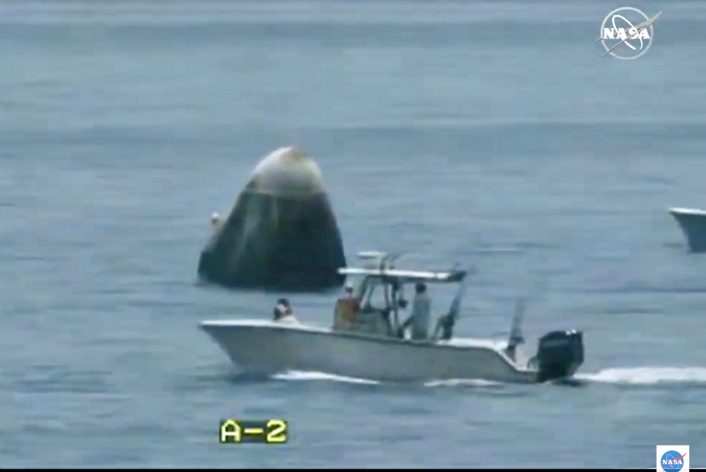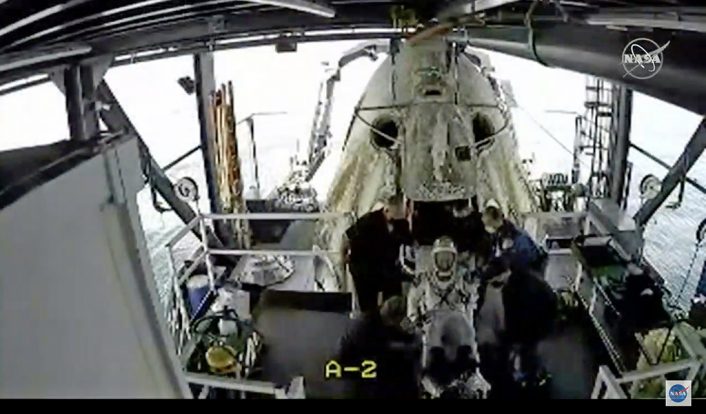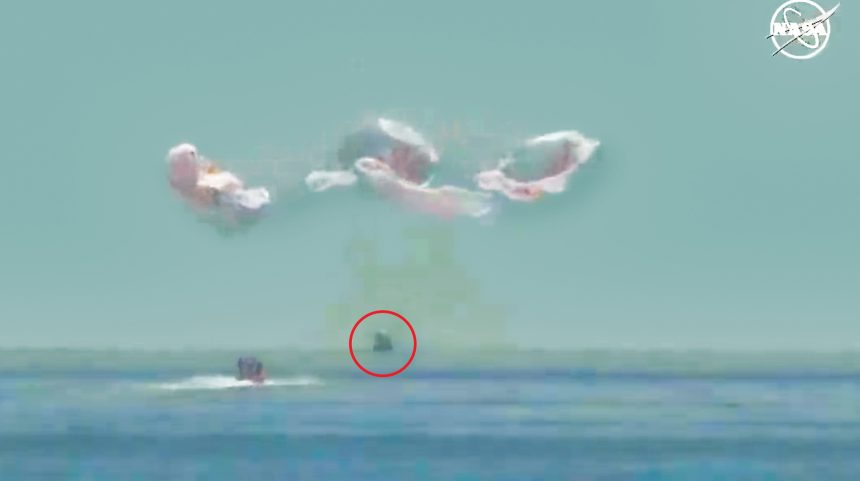First Splashdown and Water Recovery of Spacecraft in 45 Years Ends in Perfect Conditions.
The SpaceX spacecraft Dragon Endeavour with astronauts Robert Behnken and Doug Hurley made a successful reentry to earth’s atmosphere and ocean recovery off the Florida coast in the Gulf of Mexico near Pensacola, Florida on Sunday Aug. 2, 2020. The spacecraft splashed down on schedule at 14:48 local time, 11:48 Hrs. Pacific Time and 18:48 UTC. Conditions for the splashdown were excellent despite the threat of Tropical Storm Isaias at the opposite side of the Florida peninsula along the Atlantic coast. The spacecraft was returning from the International Space Station after a 64-day test mission.
“We had perfectly clear skies, we were able to see the parachutes far away and follow them to splashdown” said LaunchAmerica reporters on the scene during the live telecast of the reentry and recovery on YouTube.
It was the first parachute splashdown of a spacecraft in 45 years when a joint Apollo-Soyuz test returned to earth in an ocean splashdown recovery. This was also the first time that a space capsule was recovered onboard a ship with the astronauts still onboard. In previous splashdown recoveries, as with the Apollo program, astronauts left the space capsule before the capsule was lifted back on shipboard.

Once the space capsule, charred and blackened from the heat of reentry into earth’s atmosphere, was hoisted onto the special support bracket onboard the recovery ship GO Navigator there was a brief delay as traces of Nitrogen Tetra Oxide gas, or “NTO”, were detected around the crew egress hatch. During the inspection of the space capsule for traces of the toxic gas from the spacecraft’s reentry thrusters, technicians in protective gear could be seen taking environmental readings from around the hatch as the recovery ship slowed visibly in the water to facilitate the careful inspection. One of the astronauts inside the capsule told mission controllers by radio, “Take your time. We’re in no hurry” as the crews worked to conduct environmental safety precautions prior to crew egress.

During the capsule recovery operation, a group of civilian spectators in boats gathered very near the space capsule in the water before it was secured and brought aboard ship. One commentator during the live broadcast was heard to say, “Maybe next time we shouldn’t announce our landing zone”. Members of the official recovery team asked the civilian boats to move away, where they were then seen to form a perimeter of spectator vessels at a safer distance from the space capsule before it was lifted onboard the recovery ship.
Aerial photos of the splash down were taken by a NASA WB-57, built in 1972.
NASA’s WB-57 high-altitude research aircraft continuing to circle following the successful splash down of Crew Dragon in the Gulf of Mexico. https://t.co/W7NKEsv13m
Among other things, the WB-57 was used to chase the total solar eclipse in August 2017: https://t.co/6trWnnWYYS pic.twitter.com/91bg8hK4Na
— Flightradar24 (@flightradar24) August 2, 2020
This latest space mission started on May 30th, 2020 and ended today in the 19-hour combined spaceflight, reentry and recovery in the Gulf of Mexico for Behnken and Hurley. The two astronauts were flown by helicopter from the recovery vessel and then by aircraft back to Houston, Texas. The test mission precedes a planned four-person operational space mission planned for September, 2020.









